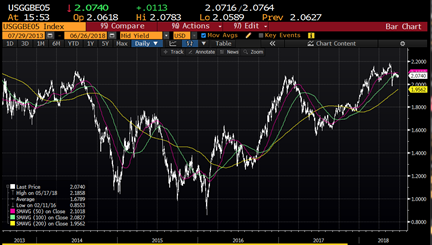If commodity price inflation continues, how will interest rates react? We have been debating this question internally for a while now as it has meaningful consequences across asset classes. For fixed income investors, understanding the potential movement on individual positions, both directional, and within the term structure is critical to protecting principal in a rising rate environment. At Bramshill, we are focused on absolute returns in fixed income in every environment.
Many of the fundamental data points portend higher rates.. Commodity prices have been increasing with the Bloomberg Commodity Index up nearly +10% over the last one year. Oil prices are approaching $70/barrel for WTI and $75/barrel for Brent. US Treasury supply issuance in the U.S. is likely to swell due to the enormous budget deficit resulting from President Trump’s spending plans. Current estimates are for a doubling of issuance in 2018 to over $1 trillion in new issues. Concurrent with the debt supply exploding, demand for US Treasuries is waning; both foreign central banks and the U.S. Federal Reserve are reducing their monthly net purchases and allowing their balance sheets to run off. Trade tensions are also likely to put upward pressure on prices. The list of inflationary pressures is long, which represents a potentially dangerous situation for bond investors.
Adding some urgency to this debate is the recently released IHS Markit Flash U.S. PMI report. Overall, private sector firms reported strong growth in business activity which is certainly good news and could point to faster economic growth in the back-half of 2018. However, in our opinion, the real story behind the numbers is the pronounced increase in operating expenses. According to the report, average input prices increased at the fastest rate since July 2013, close to a five year high. Many respondents reported higher prices for metals and oil-related costs. This is just the latest evidence of rising input price inflation. Consider the following quote from Chris Williamson, Chief Business Economist at IHS Markit:
“Input costs measured across both manufacturing and services are rising at the fastest rate for nearly five years, with the goods-producing sector seeing the steepest cost increases for seven years in recent months. Furthermore, supplier delivery delays, a key forward-indicator of inflationary pressures, have risen to the highest seen in the 11 year survey history. Rising demand has stretched supply chains to the extent that suppliers are increasingly able to demand higher prices. At the same time, higher oil and energy prices are pushing up firms’ costs.”
One of our favorite indicators for future inflation expectations is the 5-year breakeven rate. Looking at the chart below, we see that breakevens bottomed in June 2017 and peaked last month (May) around 2.2%. This implied 5-year inflation rate was trending towards the highest level of the cycle.

Source: Bloomberg
The risk here is that if commodity prices, and oil in particular, continue to rise, inflation expectations could also continue to rise which would likely push this breakeven rate even higher. As rates reset higher, the disruption to the bond market could be severe as potential losses mount in passive fixed income strategies.
Over the past few weeks, the debate concerning the potential impacts of the factors listed above has become more complicated. Turmoil in Europe around Italian elections and concerns over a strong dollar pressuring emerging markets has temporarily subdued the rise in US Treasury rates. This has led to speculation the Fed may pause its tightening path. This simply highlights the challenging discussion around the path of rates and presents further evidence that active management with a focus on capital preservation will be critical.
As always, please reach out to the Bramshill team if you would like to discuss this further.
Interested in more Bramshill market insights? Click here to visit our blog.

Did you miss our live Q1 2018 webinar?
Watch the webinar replay here.

Past performance may not be indicative of future results, which may be impacted by unforeseen economic events or evolving market conditions. The indices quoted are included for illustrative purposes only, as an index is not a security in which an investment can me made. Certain statements are forward-looking and may not come to pass.







